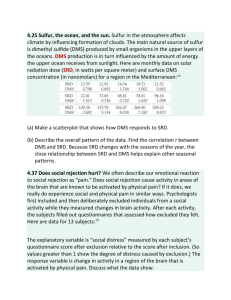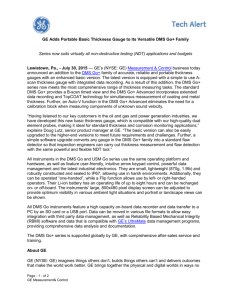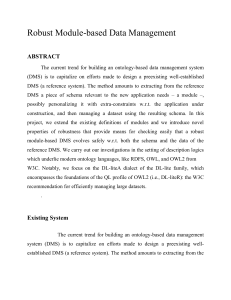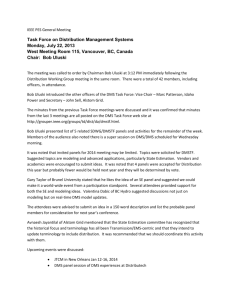Pages 183-184 Published Online: 22 Feb 2009 Occupational
advertisement
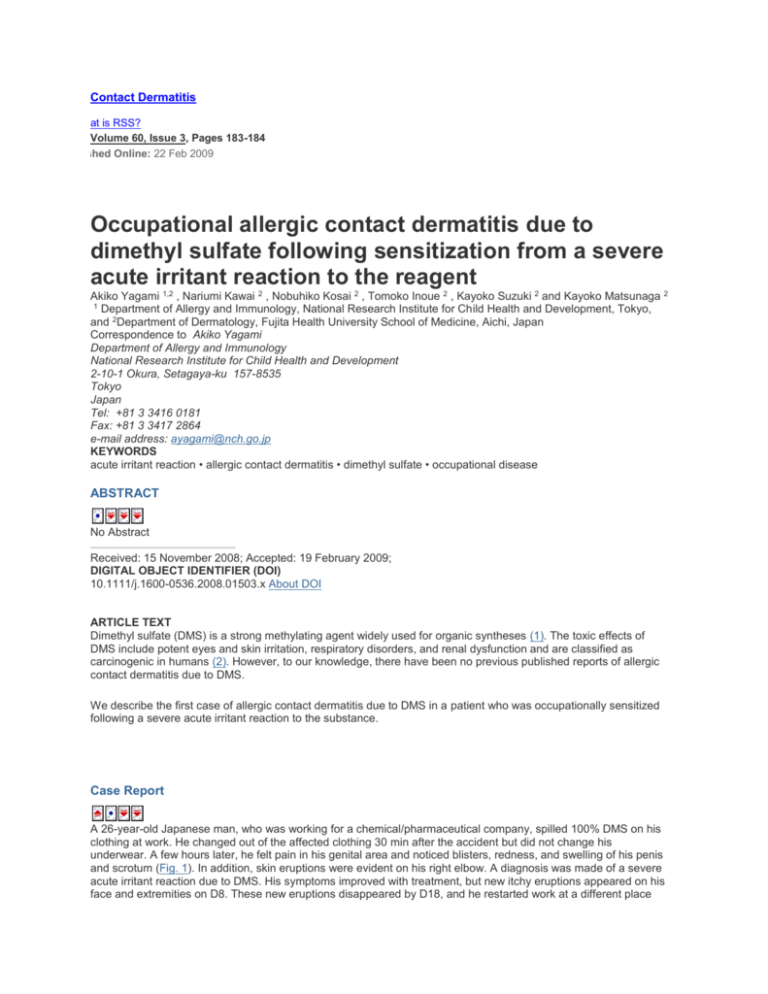
Contact Dermatitis What is RSS? Volume 60, Issue 3, Pages 183-184 Published Online: 22 Feb 2009 Occupational allergic contact dermatitis due to dimethyl sulfate following sensitization from a severe acute irritant reaction to the reagent Akiko Yagami 1,2 , Nariumi Kawai 2 , Nobuhiko Kosai 2 , Tomoko Inoue 2 , Kayoko Suzuki 2 and Kayoko Matsunaga 2 1 Department of Allergy and Immunology, National Research Institute for Child Health and Development, Tokyo, and 2Department of Dermatology, Fujita Health University School of Medicine, Aichi, Japan Correspondence to Akiko Yagami Department of Allergy and Immunology National Research Institute for Child Health and Development 2-10-1 Okura, Setagaya-ku 157-8535 Tokyo Japan Tel: +81 3 3416 0181 Fax: +81 3 3417 2864 e-mail address: ayagami@nch.go.jp KEYWORDS acute irritant reaction • allergic contact dermatitis • dimethyl sulfate • occupational disease ABSTRACT No Abstract Received: 15 November 2008; Accepted: 19 February 2009; DIGITAL OBJECT IDENTIFIER (DOI) 10.1111/j.1600-0536.2008.01503.x About DOI ARTICLE TEXT Dimethyl sulfate (DMS) is a strong methylating agent widely used for organic syntheses (1). The toxic effects of DMS include potent eyes and skin irritation, respiratory disorders, and renal dysfunction and are classified as carcinogenic in humans (2). However, to our knowledge, there have been no previous published reports of allergic contact dermatitis due to DMS. We describe the first case of allergic contact dermatitis due to DMS in a patient who was occupationally sensitized following a severe acute irritant reaction to the substance. Case Report A 26-year-old Japanese man, who was working for a chemical/pharmaceutical company, spilled 100% DMS on his clothing at work. He changed out of the affected clothing 30 min after the accident but did not change his underwear. A few hours later, he felt pain in his genital area and noticed blisters, redness, and swelling of his penis and scrotum (Fig. 1). In addition, skin eruptions were evident on his right elbow. A diagnosis was made of a severe acute irritant reaction due to DMS. His symptoms improved with treatment, but new itchy eruptions appeared on his face and extremities on D8. These new eruptions disappeared by D18, and he restarted work at a different place from where he had had the contamination. However, he wore the same shoes that had been previously exposed to DMS. Several hours after resuming work, itchy erythema recurred at the sites previously affected by the acute irritant reaction (Fig. 2). A skin biopsy from the left thigh showed epidermal hyperplasia, sponginess, and a dense perivascular cell infiltrate from the shallow to deep layers of the dermis (Fig. 3). We suspected that he now had allergic contact dermatitis to DMS, and to assess this, we performed patch testing using a DMS dilution series (0.1% pet. to 0.0001% pet.) in white pet. One week later, there was a positive skin reaction to 0.1% pet. DMS (Table 1). There was no reaction to 0.1% pet. DMS in two controls. On the basis of these results, we diagnosed our patient as having allergic contact dermatitis to DMS and concluded that a suitable concentration of DMS for patch testing was 0.1% pet. Fig. 1. Clinical symptoms in the genital area at the first visit. [Normal View ] Fig. 2. Recurrence of symptoms after returning to work. [Normal View ] Fig. 3. The skin biopsy specimen (haematoxylin and eosin staining) showed epidermal hyperplasia, partial parakeratosis, sponginess, and a dense perivascular cell infiltrate in the region, comprised primarily of lymphocytes and eosinophils, from the shallow to deep layers of the dermis. [Normal View ] Table 1. Patch test results Material Concentration base D2 Patient D3 D7 D2 DMS 1% pet. 0.1% pet. 0.01% pet. 0.001% pet. 0.0001% pet. + +? − − − + +? − − − + − − − − ++ + − − − Control (n = 2) D3 D7 + − − − − +? − − − − Other substances* − − − ND ND ND In the patch test, there was a positive skin reaction to 0.1% pet. DMS. There was no reaction to 0.1% pet. DMS in two controls. *Other substances that the patient had possibly contacted at the time of his return to work. ND, not done; pet., petroleum. Discussion We report the first known case of allergic contact dermatitis caused by DMS, diagnosed on the basis of the patch test results and histological findings. From the case history, we surmise that he became sensitized to DMS when he first suffered the severe acute irritant reaction. Although he changed work places, when he returned to work, he wore the same shoes that had been contaminated with DMS. Although DMS is known as an agent for methylation of phenols, amines, and thiols, this chemical is highly toxic. DMS is considered carcinogenic and mutagenic, poisonous, corrosive, environmentally hazardous, and volatile. In establishments that use DMS, there is a duty to provide employees with appropriate information for handling the substance and protective clothing. DMS is a chemical substance that is capable of inducing allergic contact dermatitis in addition to being corrosive and carcinogenic. Full caution regarding the safety control for DMS in the work place is essential. References 1. Ellenhorn M J. The hydrocarbon products. In: Ellenhorn's Medical Toxicology: Diagnosis and Treatment of Human Poisoning, 2nd edition, Ellenhorn M J (eds): Baltimore, Williams and Wilkins, 1997: 1427–1429. 2. Rippey J C R, Stallwood M I. Nine cases of accidental exposure to dimethyl sulphate – a potential chemical weapon. Emerg Med J 2005: 22: 878–879. Links
